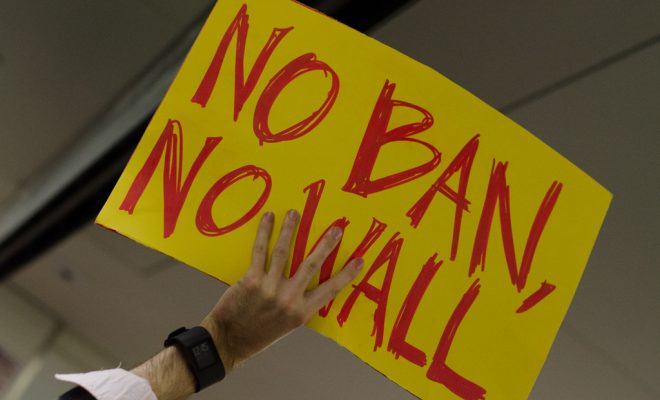 Image courtesy of Daniel Arauz; License: (CC BY 2.0)
Image courtesy of Daniel Arauz; License: (CC BY 2.0)
Politics
Confusion, Chaos, and Court Orders: What’s Going on With Trump’s Travel Ban?
At almost 5 p.m. on Friday, President Donald Trump signed an executive order, a travel ban, restricting entry to the United States. It has been dubbed by many a “Muslim ban” because of the countries it singles out and Trump’s consistent campaign promises to that effect. Chaos reigned Friday night and into Saturday, as permanent U.S. residents from those seven countries who were traveling abroad were prevented from returning home, protests were launched at numerous domestic airports, and late last night, a federal judge stayed the order for individuals with valid visas who are already in transit or being held in the U.S.
What does the Order Say?
The order is in almost every way a unilateral move by President Trump. It prevents citizens of seven countries–Iran, Iraq, Libya, Somalia, Sudan, Syria, and Yemen–from entering the U.S. for 90 days. There are some narrow exceptions, but they’re limited mainly to diplomats. The order heavily invokes memories of 9/11, despite the fact that none of the countries listed were ever tied to those attacks.
Refugees, from any nation, are banned for 120 days. And per the executive order, Syrian refugees are banned indefinitely. When refugees are allowed back in, Christian refugees will be prioritized. According to the order:
Upon the resumption of USRAP admissions, the Secretary of State, in consultation with the Secretary of Homeland Security, is further directed to make changes, to the extent permitted by law, to prioritize refugee claims made by individuals on the basis of religious-based persecution, provided that the religion of the individual is a minority religion in the individual’s country of nationality.
Despite claims from the Trump Administration that this is not a “Muslim ban” Rudy Giuliani claims that Trump asked him how to legally create a “Muslim ban.”
Giuliani admits Trump asked him how to “do a Muslim ban legally.” So they focused on nationality. Start at 3:00. https://t.co/9orjNwQBGy
— Evan McMullin (@Evan_McMullin) January 29, 2017
For a closer look at the order, check out an annotated version by the New York Times.
How Does it Work in Practice?
It’s very unclear how this order is supposed to work, and from the second it was signed, it sparked confusion. Reportedly, the Department of Homeland Security–the department that has to implement it–was not consulted until right before the order was signed. Certain norms, like consulting the Justice Department’s Office of Legal Counsel, appear to have not been undertaken. And once the order was signed, the Department of Homeland Security’s legal understanding of how to deal with it was allegedly overridden by Trump’s chief strategist Steve Bannon and Stephen Miller, a top policy aide. The “two Steves” insisted that legal permanent residents, also known as green card holders, from the listed countries be stopped from re-entering the U.S.
That implementation began. People who are legal permanent residents from the seven countries and had left the U.S. for whatever reason–students, individuals visiting family, vacationers–were restricted from coming back in to the U.S. Protests swelled at airports:
“No hate, no fear, Muslims are welcome here”
— Protests at JFK airport where people have been detained after Trump’s executive order pic.twitter.com/SvXba2C0r5
— BuzzFeed News (@BuzzFeedNews) January 28, 2017
The #MuslimBan airport protests. #NoBanNoWall #Resist @realDonaldTrump @POTUS pic.twitter.com/Ulw8xcOARN
— Maxim Dmitriev (@max_dmitriev07) January 29, 2017
Airport protests at #JFK, #LAX, #SFO, Dulles, O’Hare and growing. #NoMuslimBan #NoBanNoWall #RefugeesWelcome #ResistOften pic.twitter.com/OZZ9dexGXo
— Mike Hudema (@MikeHudema) January 28, 2017
Lawyers began suing to block the order, and last night Judge Ann M. Donnelly of the Federal District Court in Brooklyn ruled that the government cannot hold legal residents who are already in the U.S., or restrict those who are in transit from entering. This still leaves a lot of people in flux, and the legal battles are sure to continue. In the meantime, the Department of Homeland Security said it would continue to comply with Trump’s directives.
National Outrage
The ban was immediately met with outrage.
We will not allow a Muslim ban in the United States of America. Here’s what I said at Logan Airport tonight. #NoBanNoWall pic.twitter.com/XqeS9Iy14e
— Elizabeth Warren (@SenWarren) January 29, 2017
If you do support the #MuslimBan today, remember this: you will be remembered as the villains of our children’s history books tomorrow.
— Wajahat Ali (@WajahatAli) January 28, 2017
I want to repeat: Green card holders were handcuffed, their social media was reviewed, and they were asked their views on Trump#MuslimBan
— Trita Parsi (@tparsi) January 28, 2017
It’s unclear what’s next. But the outrage is warranted–this is an unprecedented move on the part of the Trump Administration. It separates families. It screams isolationism and bigotry. It’s likely unconstitutional. And for many, it’s a nightmare.








Comments